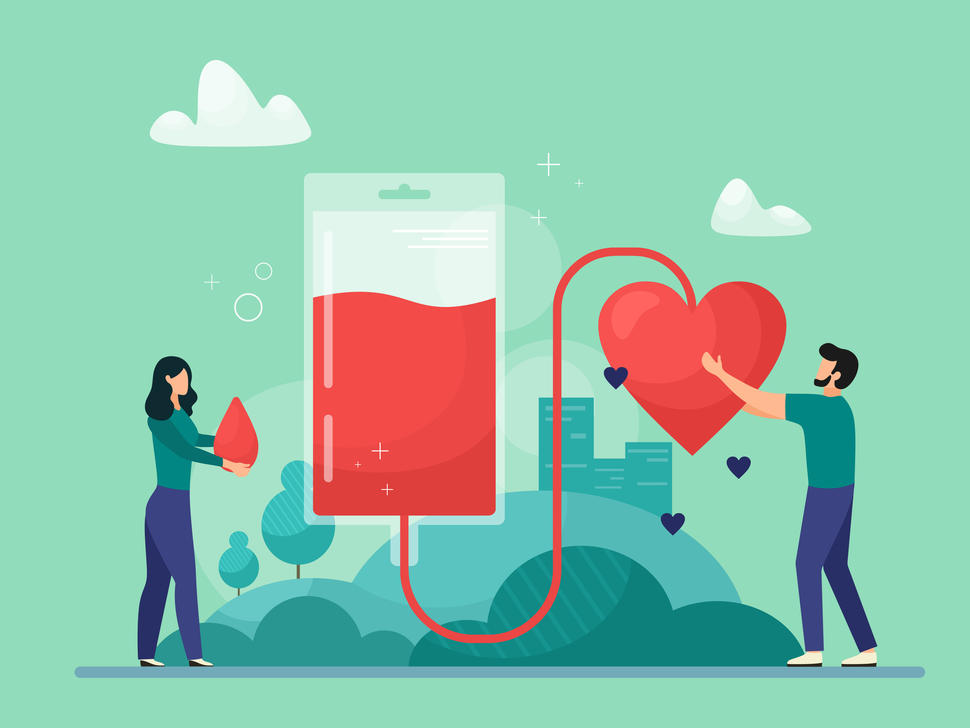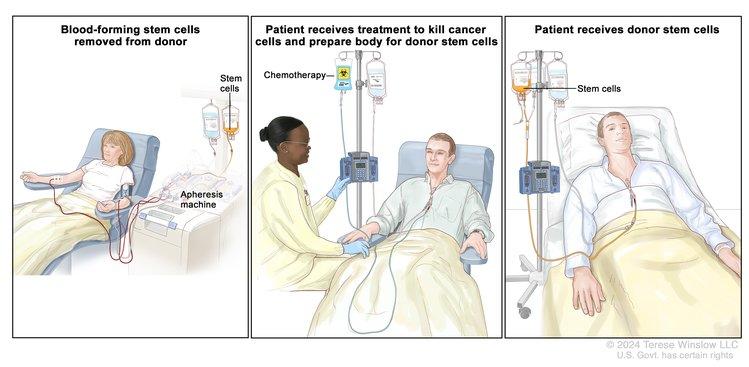How are blood stem cells collected for a stem cell transplant?
Blood stem cells used in a stem cell transplant can be collected from the bone marrow or blood. Donor blood stem cells can also come from the umbilical cord of a newborn baby.
If you are having an autologous stem cell transplant, your stem cells will be collected before you start treatment.
Collecting blood stem cells from bone marrow
Bone marrow is the liquid center of the bone and is rich in blood stem cells. Cells from the bone marrow are collected with a thick needle that is inserted through your skin and into your hip bone. For this procedure, you will need general anesthesia, which puts you to sleep.
It takes an hour to 90 minutes to harvest enough stem cells for a transplant.
Stem cells from bone marrow can be frozen and preserved for many years.
Collecting stem cells from blood
Stem cells from the blood are collected from your bloodstream through a central venous catheter or a large vein in your arm. During this procedure, the blood flows through a machine that removes the stem cells. Then it returns your blood back to you. It takes 4 to 6 hours to complete this process, which is called apheresis or leukapheresis. Once the stem cells are collected, they can be frozen until you are ready for them. You may need to have a second collection if enough cells are not collected on the first day.
Four to five days before your stem cells are collected, you will receive medicine to increase the number of stem cells flowing through your bloodstream.
Collecting stem cells from an umbilical cord
To donate umbilical cord blood, parents must contact a cord blood bank before the baby is born to arrange for the collection of the blood.
After the baby is born and the umbilical cord has been cut, blood is retrieved from the umbilical cord and placenta. The blood is then processed and frozen for future use.
About cord blood banks
Cord blood banks may be public or commercial. Public cord blood banks accept donations of cord blood. They store the cord blood until it is a match for someone who needs a stem cell transplant. Commercial cord blood banks charge money to store the cord blood for the family of the baby in case it is needed later for the baby or another family member.
Only a small amount of blood can be retrieved from the umbilical cord and placenta, so the collected stem cells are most often used for children or small adults.
What are the risks of donating blood stem cells?
Risks of donating bone marrow
The most serious risk of donating bone marrow involves the use of anesthesia during the procedure. General anesthesia is safe but is the type of anesthesia most likely to cause problems. The most common problems are nausea, vomiting, chills, and confusion. If you do have problems like this, you should be better in a day or two. You might also have a sore throat caused by a breathing tube.
Though rare, there is also a risk of a very serious allergic reaction to the anesthesia. Other side effects include reduced blood pressure, headache, and pain at the site of where the needle was inserted.
The area where the bone marrow was taken out may feel stiff or sore for a few days.
You may feel weak and tired until your body replaces the bone marrow that you donated. Some people are back to normal within a few days. Others may take several weeks to fully recover their strength.
Risks of donating stem cells from the blood
Apheresis might cause a small amount of discomfort. During apheresis, you may feel lightheaded and have chills, numbness around the lips, and cramping in the hands.
The medicine that you receive to increase the number of stem cells in the bloodstream may cause flu- like symptoms, bone and muscle aches, headaches, fatigue, nausea, vomiting, and difficulty sleeping. These side effects should stop 2 to 3 days after the last dose. You can take acetaminophen (such as Tylenol®) for these symptoms and report to your doctor if they get worse.
Risks of donating umbilical cord blood
Donating cord blood involves no risks to the mother or the baby.
What are the costs of donating blood stem cells?
All medical costs for stem cell donation are covered by the nonprofit Be The Match® program, or by the patient or patient’s health plan. Travel expenses and other costs are also covered. The only cost to you, the donor, might be time taken off from work.
You can donate your baby’s umbilical cord blood to public cord blood banks at no charge. But commercial cord blood banks charge to store the cord blood for your family’s private use.
How to become a blood stem cell donor
The National Marrow Donor Program, a nonprofit organization, manages the Be The Match® Registry, which helps connect patients with matching donors.

